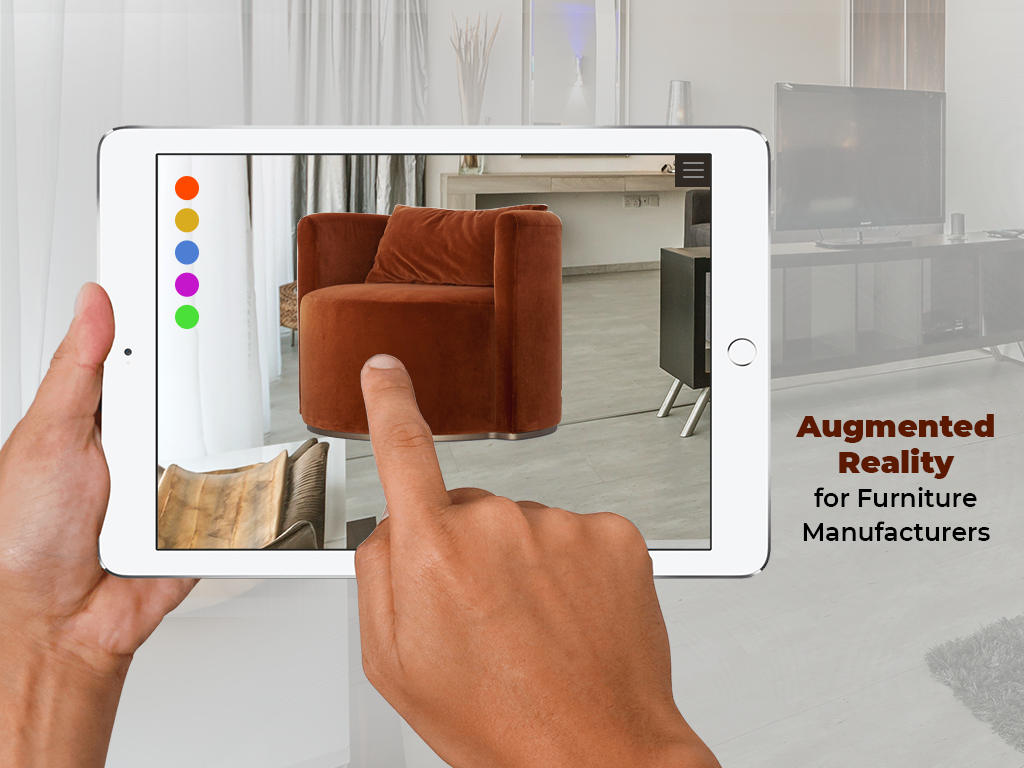
How Augmented Reality Revolutionized the Furniture Industry?
December,2020
The biggest challenge when shopping for furniture online is the lack of customers' imagination. People might fall in love with a particular sofa but cannot imagine what it would look like in their living room or whether the solid real wooden table will fit into the dining room. The furniture industry is increasingly turning to Augmented Reality — in short, AR to address this problem.
This innovative technology involves the expansion of the real world through virtual aspects. All that is needed is a smartphone or tablet. This AR solution is accessible and usable for everyone through apps, which are easily installed on any mobile device.
The customer then looks through his device's camera in the room in which the desired piece of furniture will be placed. The software now enriches this scene with the virtual preferred element — the Virtual Twin. The AR software enables customers to view their home photo-realistically, true to scale, and from all perspectives before buying it.
Reduce post-purchase discrepancies and return rates in e-commerce through AR for furniture
The virtual product presentation makes it possible, especially in e-commerce, to place products of any type and size virtually and true to scale in your own living space — be it the sofa, the dining table, or an entire wall unit. In this way, the customer can see whether the selected piece of furniture fits into the room, move it around, and view it from all perspectives. With AR for furniture, different furnishings elements are presented authentically and emotionally, stimulating the customer's imagination. This process enables the customer to make better purchasing decisions, which reduces post-purchase dissonances and the return rate to a minimum even before the purchase. AR for furniture in one sentence: What you see is what you get!
Use of AR in stationary trade
AR is also gaining ground in the stationary trade as a supplement to customer consulting. Virtual product catalogs offer retailers an innovative way to support customers' purchasing decisions and reduce complexity. With the Web AR, traders and manufacturers no longer need to have all products available on-site because the virtual representation of AR furniture simply and easily expands the limited sales area.
With a 3D Configurator's help, the furniture of choice can be individually designed, and the appropriate dimensions selected. Should the Recamier stand on the left or right side of the sofa? Should the sofa cover be velveteen or have structure? Once the customer has decided on his piece of furniture, he can virtually "take it home" on his smartphone before buying it and "try it out" again in his own four walls. If the customer still needs more input before the actual purchase, he can send the new sofa via a Web AR link to family and friends for their opinion.
Integrated order processing due to continuous processes
The combination of a 3D Configurator and Organizer results in an optimized data flow. Order data can be transferred directly from the point of sale to production. The AR software brings many advantages to the furniture industry, from the individual 3D furniture configuration to simplifying order processes right through to uncomplicating data entry and administration.
Optimizing internal business processes with Augmented Reality
Not only e-commerce and stationary traders can benefit from virtual technologies. Augmented Reality is an excellent intermediate medium within companies, for example, to combine product photography and visualization.
The photo-realistic representation of the furniture in AR or three-dimensional space presents marketing with fewer challenges. Using real-time rendering, high-resolution 3D furniture cut-outs are quickly and affordably produced.
This means it is no longer necessary to photograph each piece of furniture individually. These photos can then be used flexibly for marketing in the product catalog, on flyers and posters, or via social media — and quickly adapted if you dislike it.
Until now, the significant disadvantage of augmented Reality was its complexity. Service providers had to be hired to build time-consuming and costly apps. Large furniture stores like IKEA have invested large sums of money over several years to present their product portfolio digitally and virtually.
In the meantime, however, solutions such as the 3D Web Configurator enable every company to create virtual product catalogs easily, securely, and most of all, cost-effectively. Corporate design can already be created in the lower five-digit range — in-house and without service providers. The only requirement is the possession of 3D or CAD data of the furniture pieces. Alternatively, 3D scans can be used, for example, with antiques.
With a web-based 3D Configurator, the data can be easily uploaded and translated into the Virtual Twin. The products are then displayed in a single view in 3D, augmented and virtual reality and can be quickly sent by the dealer or customer via a link.
Advantages of AR for furniture at one glance
- Graphic order entry for the requirements of the furniture industry
- Quick and safe configuration of individual furniture
- Automated generation of worktops, skirting boards
- Single-Data-System: Direct transfer of planning into the order processing
- Fast creation of order documents
- Parts lists and production data at the click of a mouse.
Conclusion
The furniture industry is experiencing a rapid wave of digitalization and change, intending to increase sales, reducing returns, and improving customer satisfaction.
Furniture retailers and e-commerce market leaders such as Ikea, Wayfair, and Houzz have already invested in Augmented Reality technology and solutions to stay ahead of the competition and attract more customers to their websites and online stores.
According to a study, customers are 11 times more likely to buy a product if they have visualized it using AR for furniture and can sample it in their own homes before buying.
Augmented Reality is undoubtedly one of the key revenue drivers for many retail industries in 2020, helping customers visualize products in their home environment and build a strong emotional connection with the product and brand.



